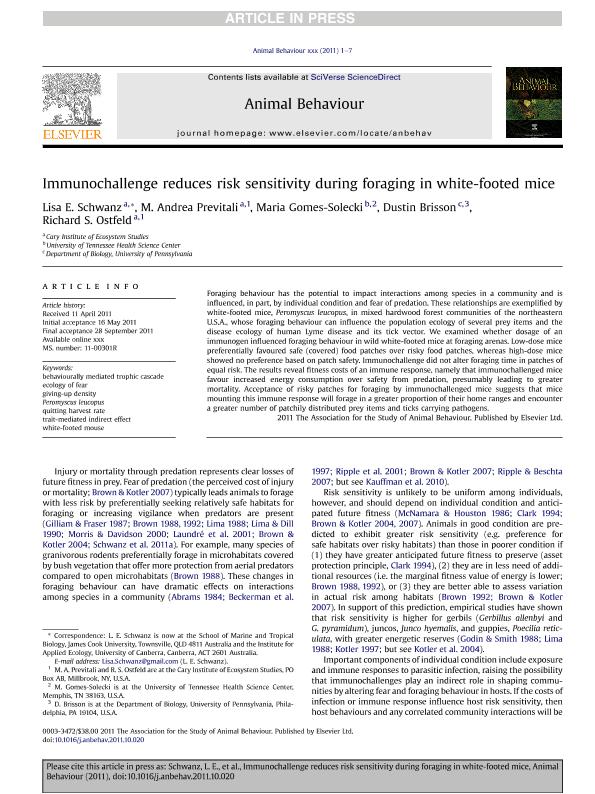Artículo
Immunochallenge reduces risk sensitivity during foraging in white-footed mice
Schwanz, Lisa E.; Previtali, Maria Andrea ; Gomes-Solecki, Maria; Brisson, Dustin; Ostfeld, Richard S.
; Gomes-Solecki, Maria; Brisson, Dustin; Ostfeld, Richard S.
 ; Gomes-Solecki, Maria; Brisson, Dustin; Ostfeld, Richard S.
; Gomes-Solecki, Maria; Brisson, Dustin; Ostfeld, Richard S.
Fecha de publicación:
01/2012
Editorial:
Academic Press Ltd - Elsevier Science Ltd
Revista:
Animal Behaviour
ISSN:
0003-3472
Idioma:
Inglés
Tipo de recurso:
Artículo publicado
Clasificación temática:
Resumen
Foraging behaviour has the potential to impact interactions among species in a community and is influenced, in part, by individual condition and fear of predation. These relationships are exemplified by white-footed mice, Peromyscus leucopus, in mixed hardwood forest communities of the northeastern U.S.A., whose foraging behaviour can influence the population ecology of several prey items and the disease ecology of human Lyme disease and its tick vector. We examined whether dosage of an immunogen influenced foraging behaviour in wild white-footed mice at foraging arenas. Low-dose mice preferentially favoured safe (covered) food patches over risky food patches, whereas high-dose mice showed no preference based on patch safety. Immunochallenge did not alter foraging time in patches of equal risk. The results reveal fitness costs of an immune response, namely that immunochallenged mice favour increased energy consumption over safety from predation, presumably leading to greater mortality. Acceptance of risky patches for foraging by immunochallenged mice suggests that mice mounting this immune response will forage in a greater proportion of their home ranges and encounter a greater number of patchily distributed prey items and ticks carrying pathogens. © 2011 The Association for the Study of Animal Behaviour.
Archivos asociados
Licencia
Identificadores
Colecciones
Articulos(CCT - SANTA FE)
Articulos de CTRO.CIENTIFICO TECNOL.CONICET - SANTA FE
Articulos de CTRO.CIENTIFICO TECNOL.CONICET - SANTA FE
Citación
Schwanz, Lisa E.; Previtali, Maria Andrea; Gomes-Solecki, Maria; Brisson, Dustin; Ostfeld, Richard S.; Immunochallenge reduces risk sensitivity during foraging in white-footed mice; Academic Press Ltd - Elsevier Science Ltd; Animal Behaviour; 83; 1; 1-2012; 155-161
Compartir
Altmétricas



